Unlocking the Secrets of CPU Cache
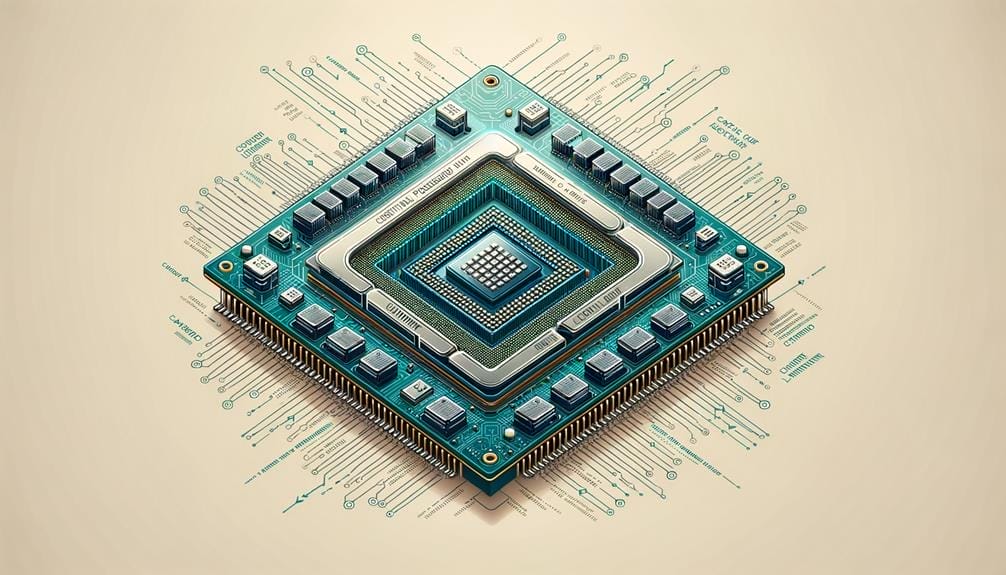
Understanding the intricate workings of the CPU cache is crucial in computing because it has a substantial impact on the performance and capabilities of modern systems. This understanding is vital for improving computing efficiency and for making educated decisions when selecting hardware components.
As we unravel the layers of CPU cache architecture and delve into its intricate hierarchy, a deeper comprehension of its significance emerges. However, the true revelation lies in the unexpected implications of CPU cache on diverse workloads, shedding light on the indispensable role it plays in the broader landscape of system optimization.
Key Takeaways
- CPU cache is memory built directly onto the CPU, which is faster than system memory (RAM).
- CPU cache helps the CPU process real-time instructions and improves performance in cache-sensitive workloads.
- CPU cache is divided into L1, L2, and L3 cache, with L1 being the fastest but having the smallest memory capacity, and L3 being the slowest but providing the largest on-CPU memory pool.
- Boosting CPU cache, especially L3 cache, can have a positive impact on gaming performance.
The Significance of CPU Cache
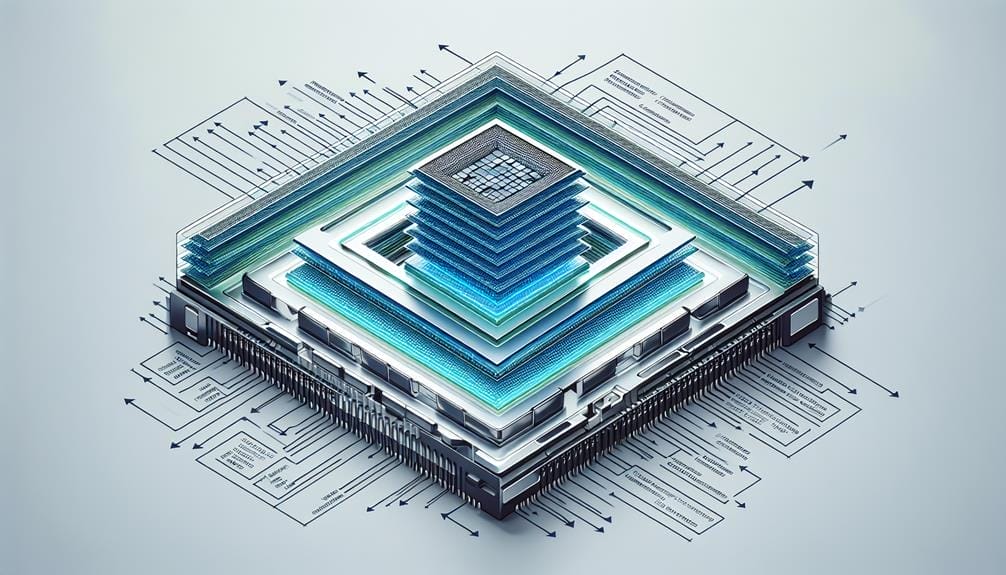
The CPU cache plays a crucial role in enhancing the performance of a computer system by efficiently managing real-time instructions and reducing the need for frequent access to system memory.
Effective CPU cache management significantly impacts the speed and efficiency of processing cache-sensitive workloads. One of the key benefits of a larger cache size is the reduction in the frequency of accessing system memory, as more data can be stored closer to the CPU for quick retrieval. This minimizes the latency involved in fetching instructions and data, thus improving overall system performance.
Larger CPU cache size also enables the system to handle larger datasets and complex computations with greater ease, making it particularly beneficial for tasks that require extensive caching of instructions and data.
Understanding CPU Cache Architecture
Discussing the intricate design and functionality of the CPU cache, particularly its architecture, provides deeper insight into how it efficiently manages real-time instructions and enhances overall system performance.
CPU cache architecture involves L1, L2, and L3 cache, with varying memory capacities and speeds. L1 cache, the fastest but smallest, is built into individual CPU cores, while L2 cache is slower but offers more memory capacity and can be distributed across CPU cores. L3 cache, slower still but providing the largest on-CPU memory pool, is shared by all CPU cores and improves the speed of L1 and L2 cache.
Larger CPU cache size reduces the need for frequent access to system memory, benefiting cache-sensitive workloads. Boosting CPU cache, especially L3 cache, can notably enhance gaming performance and 1% low performance in benchmarks, demonstrating the advantages of a larger cache size in CPU cache management.
Different Levels of CPU Cache
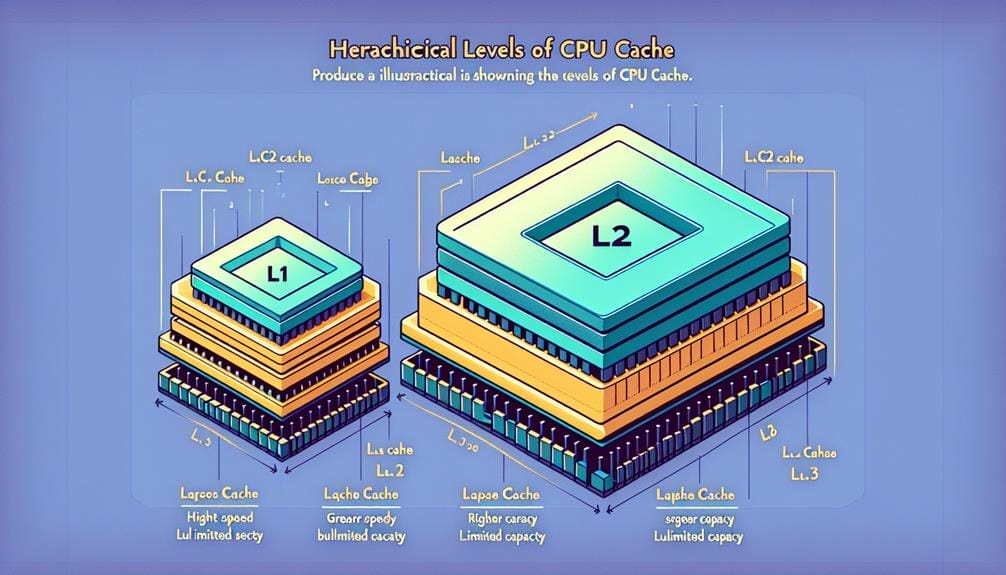
Different levels of CPU cache play a critical role in managing and optimizing the performance of a CPU system.
The L1 cache is the primary CPU cache, with the fastest access but the smallest memory capacity.
L2 cache, the secondary CPU cache, is slower than L1 but offers more memory capacity.
Meanwhile, L3 cache, slower than L1 and L2 cache, provides the largest on-CPU memory pool and is shared by all CPU cores.
The benefits of a larger cache include reducing the need for frequent access to system memory and improving the speed of L1 and L2 cache.
Boosting CPU cache can significantly enhance performance in cache-sensitive workloads, and larger L3 cache has been shown to positively impact gaming performance, particularly in improving 1% low performance in gaming benchmarks.
Impact of CPU Cache on Performance
Moving from the discussion on different levels of CPU cache, it is essential to examine the direct impact of CPU cache on system performance.
CPU cache management significantly influences performance, with cache size playing a crucial role. Larger cache sizes generally reduce the need for frequent access to system memory, improving performance in cache-sensitive workloads.
For instance, boosting L3 cache has shown a positive impact on gaming performance, with larger L3 cache sizes improving 1% low performance in gaming benchmarks.
However, the impact of cache size on performance can vary across different workloads, as increasing L3 cache may not necessarily provide a significant performance boost in content creation tasks.
Therefore, understanding the specific requirements of the intended workloads is essential when considering the impact of CPU cache size on overall system performance.
CPU Cache and Workload Optimization

Optimizing CPU cache for specific workloads is paramount in achieving efficient system performance. When considering CPU cache and machine language optimization, several factors come into play:
- Understanding the nature of the workload and its cache sensitivity.
- Identifying the specific instructions and data patterns that the workload frequently accesses.
- Evaluating the benefits of a larger CPU cache in real-time applications, such as reduced latency and improved data access.
Exploring L3 Cache in Gaming
Exploring the impact of L3 cache size on gaming performance provides valuable insights into the role of CPU cache in optimizing real-time data access for gaming workloads.
The size of L3 cache has a significant impact on optimizing cache performance in gaming. Larger L3 cache sizes have shown to improve gaming performance by reducing the need for frequent access to system memory, resulting in better 1% low performance in gaming benchmarks.
When considering the impact of cache size, it becomes evident that boosting L3 cache has a positive impact on gaming performance.
As such, understanding the relationship between L3 cache size and gaming performance is crucial for optimizing gaming workloads and ensuring efficient real-time data access.
Rare L4 Cache in CPU Memory
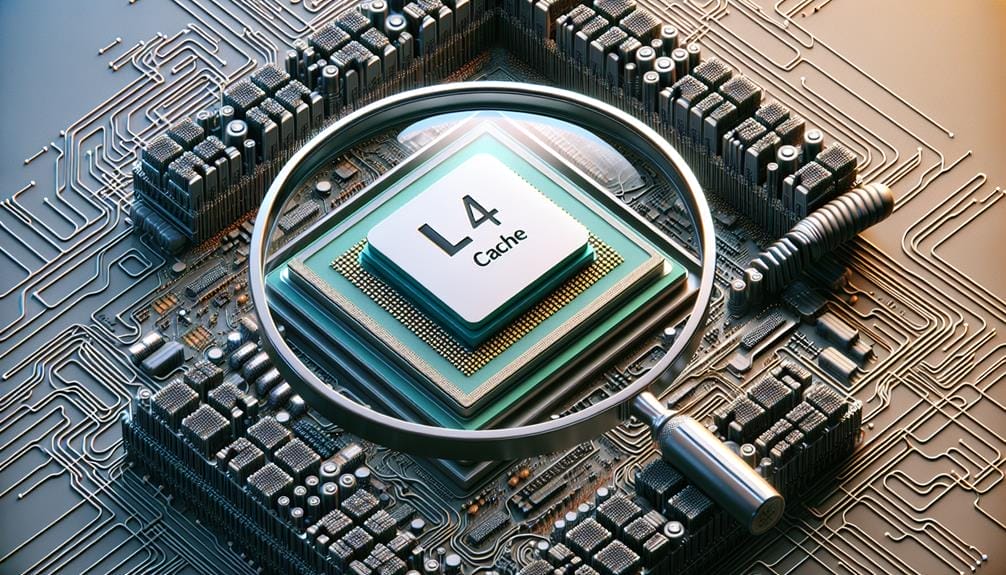
The discussion on the impact of L3 cache size on gaming performance highlights the significance of CPU cache in optimizing real-time data access for specific workloads, prompting an exploration of the rare L4 cache in CPU memory.
- L4 cache advantages:
- L4 cache provides a higher-capacity on-die CPU memory.
- It offers a lower-speed memory pool, complementing the faster L1, L2, and L3 caches.
- L4 cache enhances the efficiency of on-chip memory hierarchy.
The evaluation of L4 cache performance is crucial for understanding its impact on CPU processing, especially for cache-sensitive workloads. Analyzing the advantages and performance of L4 cache can provide insights into its potential benefits for specific computational tasks.
CPU Cache and Memory Hierarchy
One of the fundamental components in modern computing architecture, CPU cache, plays a pivotal role in the intricate memory hierarchy of a processor.
CPU cache management directly impacts the performance of a processor, with the size of the cache being a critical factor. The impact of cache size on the memory hierarchy is significant, as larger caches reduce the need for frequent access to system memory.
This, in turn, results in improved processing speed and efficiency, particularly in cache-sensitive workloads. The intricate memory hierarchy, consisting of L1, L2, and L3 caches, is designed to optimize the retrieval of data and instructions, with each level serving a specific purpose in enhancing the overall performance of the CPU.
Therefore, understanding and optimizing CPU cache management is crucial for achieving optimal processor performance.
CPU Cache in Desktop CPUs
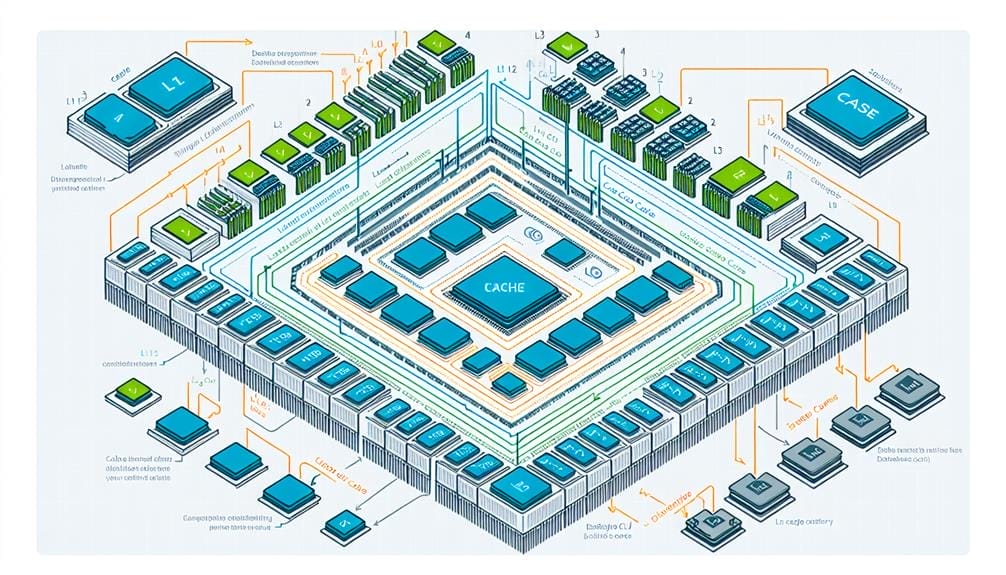
In modern desktop CPUs, the management and optimization of CPU cache play a critical role in enhancing overall processing efficiency and performance.
- CPU Cache Management
- Efficient allocation and retrieval of data from the cache is crucial for smooth operations.
- Balancing the cache size and associativity is essential for maximizing its effectiveness.
- Implementing intelligent cache replacement policies is vital to minimize cache misses.
The latency of the CPU cache is a key consideration in desktop CPUs as it directly impacts processing speed and responsiveness.
Efficient management and minimizing latency are pivotal for achieving optimal performance in desktop CPUs.
Considerations When Choosing a CPU
Efficient management and optimization of CPU cache are critical factors to consider when choosing a CPU for desktop systems, as they directly impact overall processing efficiency and performance.
CPU cache, being faster and more expensive than system memory (RAM), plays a crucial role in reducing the need for frequent access to system memory.
The size of the CPU cache, especially the L3 cache, is of significant importance in cache-sensitive workloads as it can improve performance, particularly in gaming scenarios.
However, it is essential to note that while a larger CPU cache can enhance performance in certain tasks, benchmarks should be considered when choosing a CPU, as the impact of CPU cache size may vary depending on the specific workload and use case.
Conclusion
In conclusion, CPU cache plays a crucial role in optimizing processing efficiency and system performance.
Understanding the architecture and hierarchy of CPU cache is essential for workload optimization, particularly in gaming and content creation.
The impact of cache size on performance cannot be overlooked, and the consideration of diverse factors, including benchmarks, is paramount when selecting a CPU.
Overall, CPU cache is a fundamental yet often overlooked aspect of CPU architecture with significant implications for real-time instructions and system operations.

